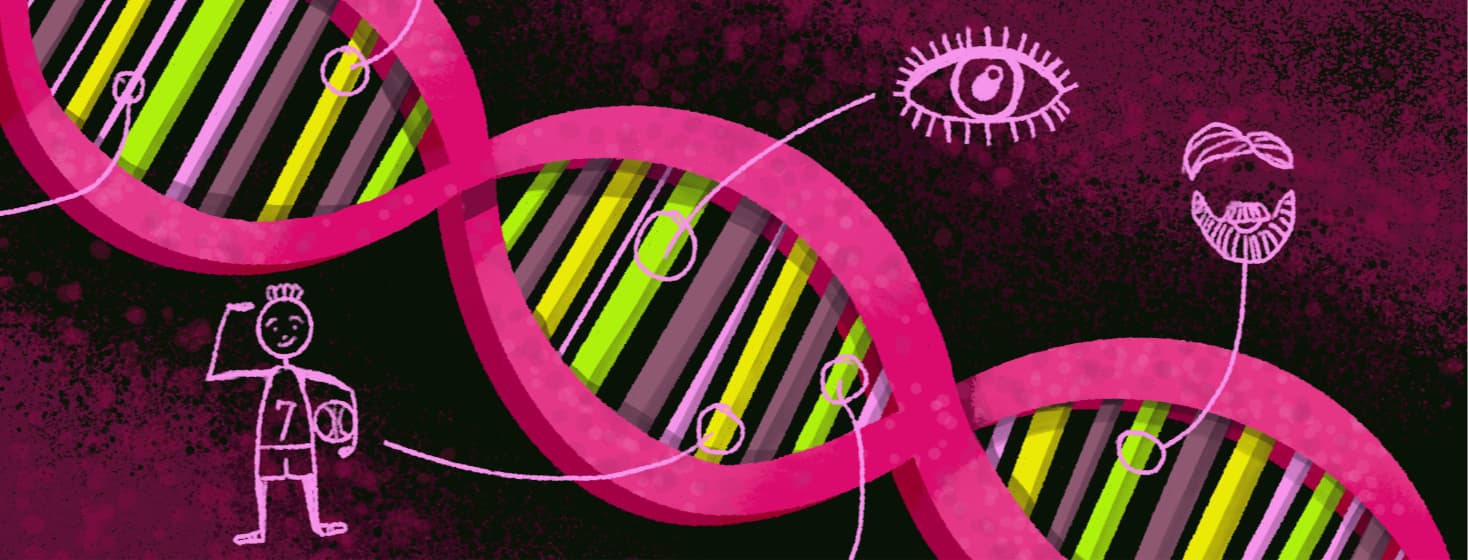Genetics 101
Our genes are like a recipe book for our bodies. They tell our cells what to do, how to grow, and how to repair themselves. Genes play a role in many aspects of our health. But there are other factors that also play a role, like lifestyle choices and the environment. A better understanding of genes can help us make informed decisions about our health and the health of our families.1
Chromosomes, genes, and DNA
Chromosomes are long strands of DNA that contain genes. Genes store information that is needed for an organism's development and function. Every gene has a sequence of DNA base pairs. These pairs determine the characteristics of an organism. For example, the gene for eye color is determined by a sequence of DNA base pairs.1
Chromosomes carry multiple genes. Genes, on the other hand, carry only a single piece of information. In humans, there are 46 chromosomes in each cell, or 23 pairs. Half come from the mother and half from the father. One pair, the sex chromosomes X and Y, determine biological sex.1,2
How our genes are passed on to us
We get our genes from our parents, who pass them down to us through their DNA. But it is not just a matter of getting half of your mom’s genes and half of your dad’s. We each get a mix of different genes from our parents, making us unique. The process of passing genes from parent to child is called heredity. Heredity is responsible for the similarities (and differences) between family members.1
What are genetic disorders?
A genetic disorder is a condition caused by an abnormality in DNA. These disorders can be divided into 2 groups – those that run in families and those that do not. So genetic disorders can be passed down from parents to children, or they can happen on their own.1
There are many different types of genetic disorders. For example:1
- Some cause physical abnormalities, while others affect thinking ability (cognitive function).
- Some disorders are relatively mild, while others can be life-threatening.
- Some disorders are dominant, while others are recessive.
Dominant
Dominant genetic disorders are caused by a change (mutation) in a single gene. If someone has a dominant genetic disorder, they have a 50 percent chance of passing the disorder on to their children. Dominant genetic disorders can be passed down from either parent. They often affect both men and women equally. Multiple sclerosis is an example of a dominant genetic disorder.1
Recessive
Recessive genetic disorders are caused by mutations in genes that are found on the non-sex chromosomes. In order for a person to be affected by a recessive disorder, they must inherit 2 mutated genes. This can happen if both parents pass on a mutated gene to their child.1
If a person inherits just 1 copy of the mutated gene, they are known as a carrier. Carriers usually do not have any symptoms, but they can pass the mutated gene on to their children. Recessive disorders can run in families, but they can also occur in people with no family history of the disorder. Some examples of recessive disorders include:1,3
- Cystic fibrosis (CF)
- Sickle cell disease (SCD)
- Spinal muscular atrophy (SMA)
What are single gene disorders?
A single gene disorder is a condition that's caused by a mutation in just one gene. Many of these conditions are passed down from parents to children. This can happen if both parents carry the same mutated gene, or if just one parent passes on the mutated gene. CF, SCD, and SMA are examples of single gene disorders.1
Chromosome abnormalities
Chromosomal abnormalities can cause a wide range of health problems. They occur when there is a change in the number or structure of the chromosomes in a person's cells. Most chromosomal flaws are caused by errors that happen when a cell is dividing. These errors can occur randomly or they can be passed down from a parent to a child.2
Numerical abnormality
Most people have 23 pairs of chromosomes. But a person may be born with a different number of chromosomes. If someone is missing 1 chromosome from a pair, they have monosomy. If someone has more than 2 chromosomes instead of a pair, they have trisomy.2
One example of a difference that can cause problems is Down syndrome. This happens when a person has an extra copy of chromosome 21. This extra copy of the chromosome can cause mental and physical problems for the person.2
Structural changes
The structure of a chromosome can be incomplete or shaped differently. These changes can include:2
- Deletions: Part of the chromosome is missing or deleted.
- Duplications: Part of a chromosome is copied, resulting in extra genetic material.
- Translocations: A piece of one chromosome is transferred to another.
- Inversions: Happen when a piece of chromosome breaks off, flips upside down, and reconnects. This changes the way the genetic material is arranged.
- Rings: Happen when a part of a chromosome breaks off and forms a circle. This can happen with or without losing any DNA.
Other conditions and genes
Some illnesses are caused by a combination of genetic and environmental factors. These are known as complex conditions. Most chronic disorders, such as heart disease, cancer, and diabetes, are complex conditions. Other rare conditions may also be complex disorders. Some examples include:1,4-6
- Myasthenia gravis
- Thyroid eye disease
- Neuromyelitis optica spectrum disorder

Join the conversation